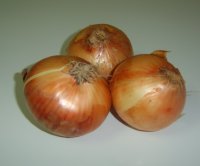Weeds
Grasses
Sedges
Broadleaf
Diseases
Fungal
Bacterial
Viral
Agro-ecology
Do not plant onions after the field has been planted with other Allium plants. Field
previously planted with corn should also be avoided because the same soil borne pests of corn will also attack onions (Boyhan; Kelly; Granberry, 2001: p. 24).
Proper seed selection is recommended to minimize problems of splits and doubles. Over-fertilization, uneven watering, and temperature fluctuations also influence double formation (Boyhan; Kelly; Granberry, 2001: pp. 11-12).
Soak seeds before sowing and seedlings before transplanting for 15 minutes in compost tea. Compost tea helps control many fungal pathogens and prevents spread of disease on healthy plants. To prepare you own compost tea, mix 1 part of well-done compost with 6 parts of water. Leave filtrate for 1 week. After straining, it is ready for use.
If bone meal is available, dust bone meal to roots to give seedlings a good start (Ellis; Bradley, 1996: pp. 155-158; 426-427).
Mulching onions with composted leaves and straws is highly recommended to maintain soil organic content,
prevent soil borne disease, and suppress weeds. Planting onions in raised beds improves drainage and prevents damping-off (Ellis; Bradley, 1996: pp. 155-156).
Further information
Tolerant cultivars against onion leaf blight, onion smudge, Fusarium bulb rot and resistant cultivars against onion maggots/flies, aphids, and wireworm are now available in the markets. Also available are varieties with longer storage life. Ask for assistance from your local agricultural office for more information on such onion cultivars (CABI, 2000; CABI, 2004).
External links
References
- Boyhan, G.; Granberry, D.; Kelly, T. (2001): Onion Production Guide. College of Agricultural and Environmental Sciences. Cooperative Extension Service, University of Georgia.
- CABI. (2000): Crop protection compendium. Global module, 2nd edition. CABI Publishing, Wallingford, UK.
- Ellis, B.; Bradley, F. (1996): The organic gardener's handbook of natural insect and disease control. Rodale Press. Emmaus, Pennsylvania.
- Shanmugasumdaran, S. (2001): Suggested cultural practices for onion. Edited by T. Kalb. AVRDC Training Guide, AVRDC.

